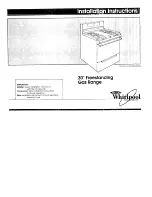
19
19
Before you call for service
, review the following list. It may save you time & expense. The list includes common occurrences (shown
in bold) that are not the result of defective workmanship or materials in this appliance. The possible corrections to these problems are
provided with the problem listed:
Solutions to common problems
•
BEFORE YOU CALL
Problem
Solution
Range is not level
(1) Poor installation. Place oven rack in center of oven. Place a level on the oven rack. Adjust leveling
legs at base of range until the oven rack is level. (2) Be sure floor is level, strong & stable enough
to adequately support range. (3) If floor is sagging or sloping, contact a carpenter to correct the
situation. (4) Kitchen cabinet alignment may make range appear not level. Be sure cabinets are square
& have sufficient room for range clearance.
Cannot move appliance
easily. Appliance must be
accessible for service
(1) Cabinets not square or are built in too tightly. Contact builder or installer to make appliance
accessible. (2) Carpet interferes with range. Provide sufficient space so range can be lifted over carpet.
Surface element too hot
or not hot enough
Incorrect control setting. Be sure the correct control is ON for the element to be used.
Surface element does
not heat
(1) Lightweight or warped pans used. Use only flat, evenly balanced, medium or heavyweight cookware. Flat
pans heat better than warped pans. Cookware materials and weight of the material affect heating. Heavy
& medium-weight pans heat evenly. Because lightweight pans heat unevenly, foods may burn easily. (2) No
power to the appliance. Check steps under “
Entire Appliance Does Not Operate
” in this
checklist. (3)
Incorrect control setting. Make sure the correct control is ON for the surface element to be used.
Entire appliance does not
operate
(1) The time of day is not set. The time of day
must
first be set in order to operate the oven. See “To
Set the Clock” in the
Setting Oven Controls
section.(2) Make sure cord/plug is plugged correctly
into outlet. (3) Service wiring is not complete. Contact your authorized service agent. (4) Electrical
power outage. Check house lights to be sure. Call your local electric company for service.
Oven does not operate
Be sure the oven controls are set properly for the desired function. See
Setting Oven Controls
in this
Use & Care Manual or read the instructions “
Entire appliance does not operate
” in this checklist.
Oven light does not work
(some models)
Replace or tighten bulb. See
Changing Oven Light
section in this Use & Care Manual.
Oven control beeps &
displays any F code error
(for example F11)
Electronic control has detected a fault condition. Press
CLEAR/OFF
to clear the display & stop
beeping. Reprogram oven. If fault recurs, record fault number. Press
CLEAR/OFF
& contact an
authorized service agent.
Flames inside oven or
smoking from oven vent
Excessive spillovers in oven. For example this will happen for pie spillovers or large amounts of grease
left on the oven bottom. Wipe up excessive spillovers before starting oven. If flames or excessive
smoke are present see “Broiling” in the
Setting Oven Controls
section.
Oven smokes excessively
during broiling
(1) Control(s) not set properly. Follow Broil instructions under
Setting Oven Controls
. (2) Make sure
oven door is opened to
broil stop position.
(3) Meat too close to the broil element. Reposition the
broil rack to provide proper clearance between the meat & the element. Preheat the broil element for
searing. (4) Meat not properly prepared. Remove excess fat from meat. Cut fatty edges to prevent
curling, but do not cut into lean. (5) Insert on broiler pan wrong side up & grease not draining. Always
place grid on the broiler pan with ribs up & slots down to allow grease to drip into pan (some models).
(6) Grease has built up on oven surfaces. Regular cleaning is necessary when broiling frequently. Old
grease or food spatters cause excessive smoking.
Poor baking results
Many factors affect baking results. Make sure the proper oven rack position is used. Center food in the
oven & space pans to allow air to circulate. Allow the oven to preheat to the set temperature before
placing food in the oven. Try adjusting the recipe’s recommended temperature or baking time. If you
feel the oven is too hot or cool, see
Adjusting Your Oven Temperature
in this Use & Care Manual.
Soil not completely
removed after Self-
Cleaning cycle
Failure to clean bottom, front top of oven, frame of oven or door area outside oven seal. These areas
are not in the Self-Cleaning area, but get hot enough to burn on residue. Clean these areas before the
Self-Cleaning cycle is started. Burned-on residue can be cleaned with a stiff nylon brush and water or
a nylon scrubber. Be careful not to damage the oven gasket.
Self-Cleaning cycle does
not work
(1) Oven control not set properly. Follow instructions under
Self-Cleaning.
(2) Self-Cleaning cycle
was interrupted. Follow steps under “Stopping or Interrupting a Self-Cleaning Cycle” under
Self-
Cleaning
.
Drip bowls are pitting or
rusting
(Coil Cooktop
models only)
(1) Foods with acids, such as tomatoes, if allowed to stand in/on bowls will cause corrosion. Remove and
wash drip bowls as soon as possible after a spill over. (2) Normal environment. Houses located along
sea coasts are exposed to salt air. Protect bowls as much as possible from direct exposure to salt air.
Drip bowls are turning
color or distorted (Coil
Cooktop models only)
Bottom surface of cookware extends beyond surface element and touches cooktop surface. This can
cause high enough temperatures to discolor the drip bowls. DO NOT use cookware of this type. Pan
sizes should be matched to the size of the element. Replacement drip bowls may be purchased from
your appliance dealer.


































